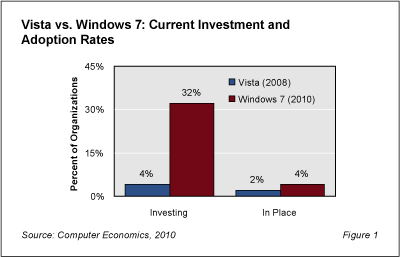Corporate America is embracing Microsoft’s Windows 7 operating system, a stark and dramatic contrast to the reticent approach shown to its Vista predecessor.
Investment in Windows 7 has been growing at a moderately steady pace since its introduction in October 2009. More importantly, current implementations and plans for investment are noticeably above investment in the Vista operating system at a comparable time, according to our study, Windows 7 Adoption and ROI and TCO Experience, based on an annual survey of 200 IT organizations.
Figure 1 shows that only 4% of organizations currently have Windows 7 in place. This is not surprising, given the short history of Windows 7. However, the percentage of organizations currently investing in Windows 7 is 32%, or almost one-third of all organizations. This indicates that enterprises are preparing for the start of significant, near-future deployments.

In contrast, our study shows that only 4% of organizations were deploying Vista at a similar point in its introduction. While many organizations at that point were considering implementation, very few organizations moved to the next stage of implementing the technology.
While technology spending remains at low levels this year, acceptance of Windows 7 appears to be on a steady upswing. Initial experiences with the new operating system have been largely positive, and as new Service Packs are introduced by Microsoft to fix obvious flaws, the adoption rate should continue to grow.
This full study examines the technology’s adoption trends, providing data on how many organizations have the technology in place, how many are in the process of implementing it, and how many are expanding implementations. To give additional insight, we look at the economic experience of those that have adopted the technology: We examine return on investment (ROI) experience in terms of the percentage of organizations that report positive and break-even ROI within a two-year period. We also balance the potential ROI against the risks, measured in terms of the percentage of organizations that exceed budgets for total cost of ownership (TCO). We conclude with a look at the potential impact of Windows 7 on the enterprise.
This Research Byte is a brief overview of our report on this subject, Windows 7 Adoption and ROI and TCO Experience. The full report is available at no charge for Computer Economics clients, or it may be purchased by non-clients directly from our website (click for pricing).

